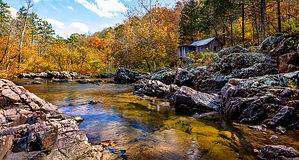In a world where trees are vital for our environment and well-being, it’s crucial to understand the dangers that certain vines pose to their survival. In this article, we delve into nine insidious vine species that can suffocate and ultimately kill trees if left unchecked. Discover how these formidable adversaries threaten our beloved arboreal companions and why vigilance is key in protecting nature’s guardians.
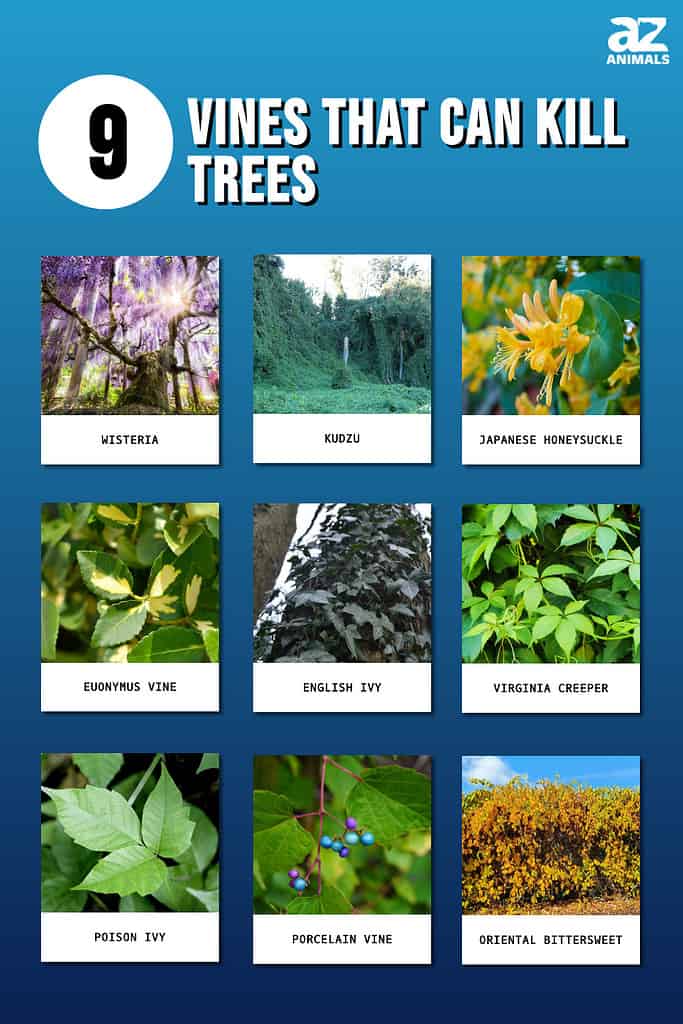
9 Vines That Can Kill Trees
Vines can enhance gardens for their visual appeal or edible benefits, but it’s important to be aware of the types of vines that can cause harm. Unmanaged vines can choke out and even kill trees, so it’s best to consult with an arborist in your area to understand how to properly take care of your vines. Taking the necessary precautions will help protect trees, humans, and animals in the vicinity.
#1 Wisteria

As you can see, wisteria vines can grow absolutely enormous and kill a tree.
©mapman/Shutterstock.com
Wisteria is a graceful, fast-growing vine with delicate, drooping purple flowers and attractive, glossy green foliage. It can grow up to 10 feet in a single season, and its long, woody stems can spread out to cover large areas. Unfortunately, wisteria can also be very destructive, as its vining habit can strangle and kill trees if left unchecked.
To prevent wisteria from causing damage, it is important to regularly prune the vine and keep it in check. This will prevent it from becoming overgrown and out of control. If the vine is already growing around a tree, it is important to remove the wisteria completely to protect the tree from being strangled. It is also important to periodically inspect the tree’s roots and branches for any signs of damage.
If wisteria is grown in a garden, provide it with a strong support structure, such as a trellis or pergola. This will help the vine to grow in a more controlled manner while still providing an attractive feature to the garden.
Overall, wisteria is a beautiful, fast-growing vine that can make a stunning addition to any garden. However, it is important to be aware of its potential to strangle and kill trees and to take appropriate action to prevent it from doing so. With regular pruning and careful maintenance, wisteria can be a wonderful addition to any garden.
#2 Kudzu

The kudzu vine is invasive across the southern United States.
Kudzu is a fast-growing, invasive vine native to Asia. It has leaves that are about three to five inches long and clusters of three to five purple-tinged flowers. It grows incredibly quickly, with some vines growing up to a foot each day in the right conditions. Unfortunately, this means that it can quickly grow out of control and overwhelm other vegetation.
Kudzu has been known to strangle and kill trees as the vines grow around the trunk and branches, blocking off the sunlight and choking off the tree’s water supply. In addition, it can quickly overrun native vegetation, including grasses and shrubs, depriving them of the resources they need to survive.
If you find kudzu growing on your property, it’s important to take action quickly. Pulling the vines up manually can help, but it’s important to be thorough and persistent. You may also want to consider using herbicides to kill the vines, though this should be done with caution. Finally, you may want to introduce natural predators of kudzu to help keep the plant under control.
#3 Japanese Honeysuckle
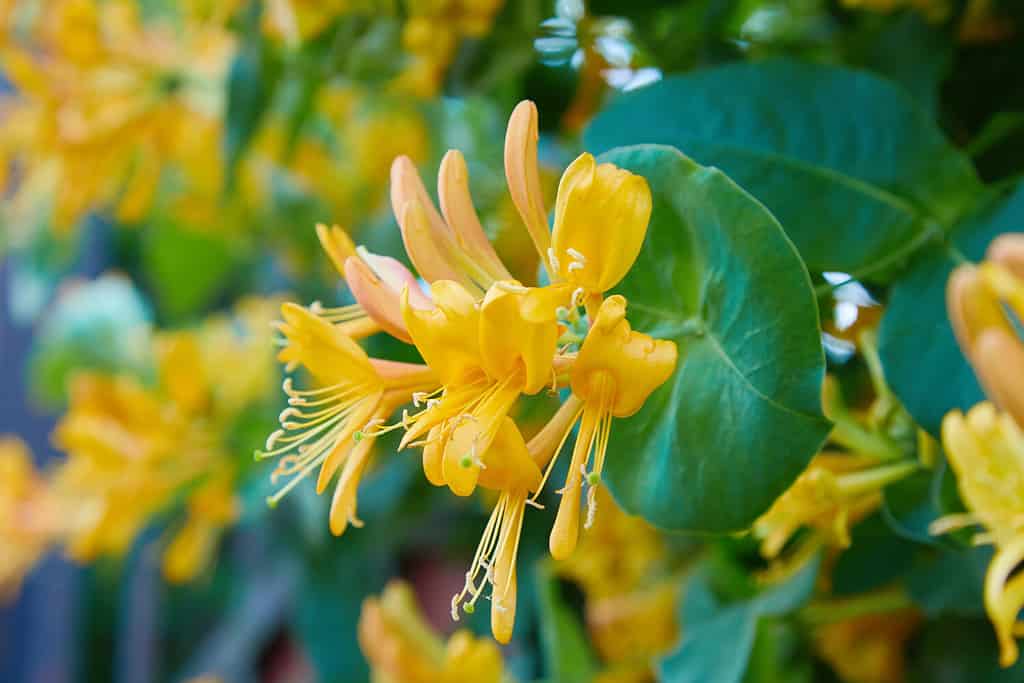
The beautiful flowers and scent of Japanese honeysuckle make it a popular plant.
©krolya25/Shutterstock.com
Japanese honeysuckle (Lonicera japonica) is a visually captivating vine notorious for its invasive nature, capable of wreaking havoc on the vegetation it encounters. Its physical appearance is characterized by lush green foliage and delicate, fragrant white flowers that gradually transform into small black berries. The leaves are opposite and oval-shaped, with deep veins running through them.
One of the most alarming aspects of Japanese honeysuckle is its astonishing growth rate. It thrives in various soil types and light conditions, rapidly climbing toward sunlight using its twining stems that can extend up to 30 feet or more within a single season. This aggressive vine possesses an uncanny ability to smother surrounding plants, including trees, as it wraps itself tightly around their trunks and branches.
Once entangled with a tree, Japanese honeysuckle exerts immense pressure on the host plant’s structural integrity, hindering nutrient absorption and ultimately leading to its demise if left uncontrolled. The suffocating embrace impedes photosynthesis by blocking sunlight from reaching the tree’s own leaves. Furthermore, this parasitic vine competes fiercely for essential resources such as water and minerals.
To combat the detrimental impact of Japanese honeysuckle on trees, proactive measures must be taken swiftly. Promptly identifying infestations is crucial in preventing further damage. Removal should begin before the vines establish firm roots or become too intertwined with their hosts’ structure.
#4 Euonymus Vine
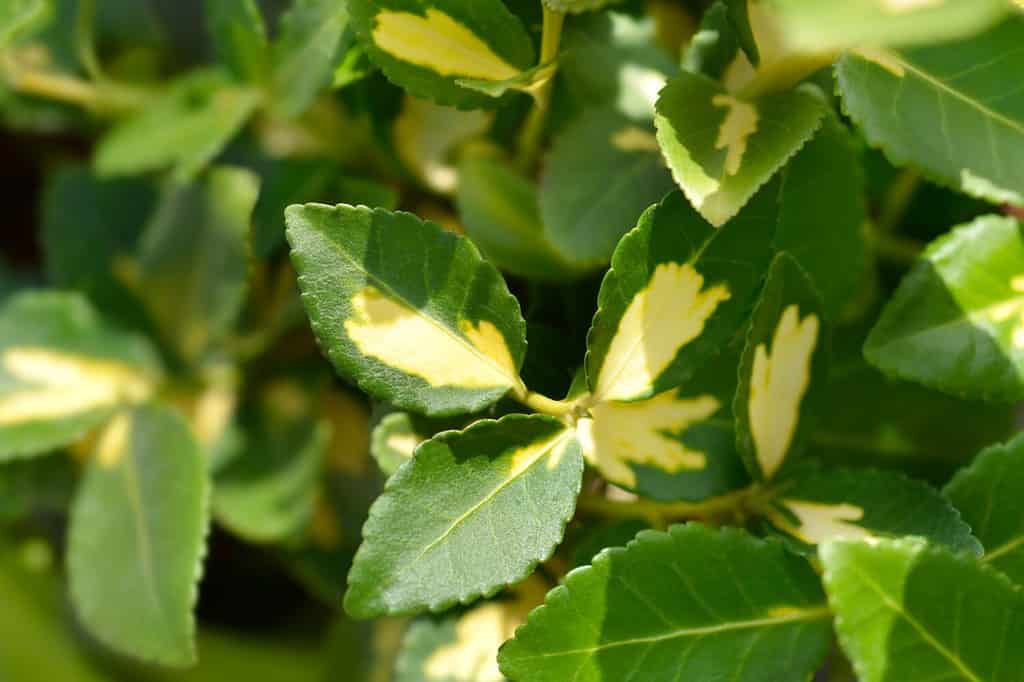
Also called wintercreeper, this vine can quickly strangle and kill a tree if left unpruned.
©Nahhana/Shutterstock.com
The Euonymus vine is a woody evergreen plant with glossy, dark green foliage and white-green flowers. It is a fast-growing, woody vine that can quickly cover fences, buildings, and trees. The vine can reach heights of up to 30 feet and has a slender, wiry stem.
The Euonymus vine is extremely invasive and can spread quickly. It can strangle and kill trees as it wraps tightly around the trunk and branches, choking off the tree’s nutrients and water supply. It also produces a dense, impenetrable canopy that blocks sunlight, leading to further stress and death.
In order to combat the spread of the Euonymus vine, prune it regularly and keep it under control. Regular pruning and manual removal of the vine can help prevent it from taking over trees and other areas. It is also important to remove the entire root system to ensure that the Euonymus vine does not regrow. Herbicides may also be used to help control the spread of the Euonymus vine, but they should only be used as a last resort.
#5 English Ivy
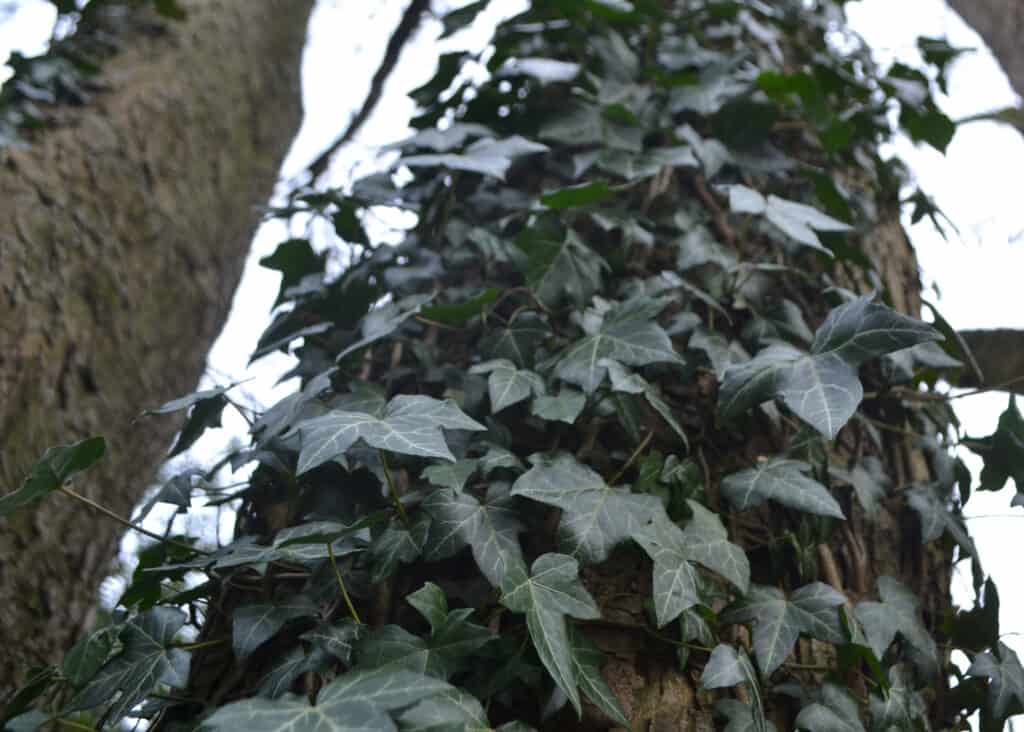
The vines of English ivy wrap around tree trunks and deprive them of nutrients and light.
©Jenn Lodge/Shutterstock.com
English ivy is a fast-growing vine characterized by its glossy, dark green leaves and small white-green flowers. It is an invasive species that can quickly overtake and strangle trees, depriving them of sunlight, water, and nutrients. English ivy climbs up the trunk of trees, and its dense foliage can block sunlight from reaching the leaves. This can lead to the death of the tree in a matter of years.
It is important to take action to control the spread of English ivy. It can be removed by hand, but it is important to wear gloves to protect your skin from the plant’s sap. If the ivy is widespread, chemical herbicides may be necessary to control the growth.
Many people appreciate English Ivy for its beauty, but it can still be dangerous. If left untrimmed, it can slowly overtake and eventually kill trees. The length of time it takes to do so is dependent on the type and size of the tree. Therefore, it’s important to be aware of the potential risks and manage them accordingly.
#6 Virginia Creeper

The amazing Virginia Creeper vine can reach up to 100 feet tall.
©iStock.com/drasa
Virginia Creeper is a fast-growing vine known for its deep green foliage and abundant clusters of purple-black berries. It has five leaflets, with each leaflet being toothed and three to five inches long. Its vines are woody and can grow up to 50 feet in length.
While the Virginia Creeper vine is a beautiful addition to many landscapes and gardens, it can also be dangerous if not managed properly. It grows very quickly, with vines reaching up to a foot per day during the summer months. If left unchecked, it can quickly take over an area, strangling and killing trees and other vegetation as it grows.
In order to keep Virginia Creeper under control, prune it regularly and keep an eye on its growth. If it is growing too quickly or taking over an area, it’s best to remove it as soon as possible. However, if you want to keep the vine in your garden, make sure to prune it back every few weeks to keep it from getting out of hand.
#7 Poison Ivy
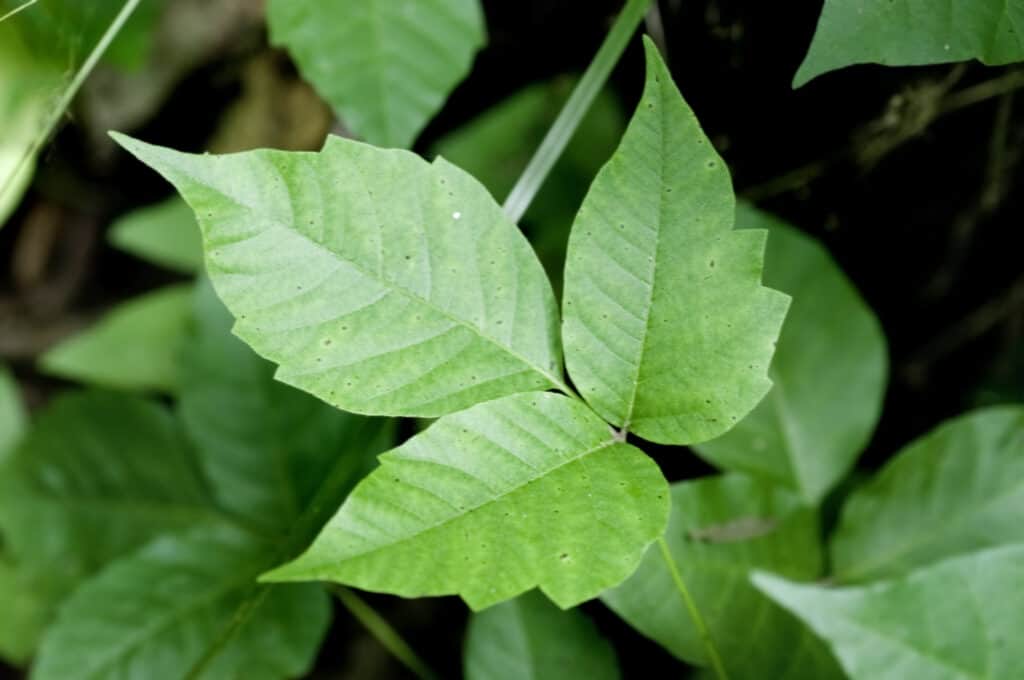
It looks completely harmless, but poison ivy poses a danger to both humans and trees.
©Tim Mainiero/Shutterstock.com
Poison ivy is a pesky and dangerous plant that can cause severe skin irritation and other health problems for humans. It’s a vine-like plant that has three shiny, pointed leaflets that range in color from dark green to reddish-purple. The leaves are commonly referred to as “leaves of three, let it be.” It grows quickly and can reach heights of up to 30 feet in some cases.
This plant is particularly dangerous to trees, as it can wrap itself around the trunk and strangle it, often killing it. It can also spread quickly to other trees, making it very difficult to contain and eradicate.
For humans, poison ivy is a serious health hazard. Contact with the plant can cause severe skin irritation that can last for weeks. In some cases, it can even cause an allergic reaction.
The best way to deal with poison ivy is to avoid it at all costs. When you come in contact with it, wash the affected area with cold water and soap as soon as possible. If the irritation persists, seek medical attention immediately. If you find it growing in your yard or garden, take steps to remove it as soon as possible.
#8 Porcelain Vine
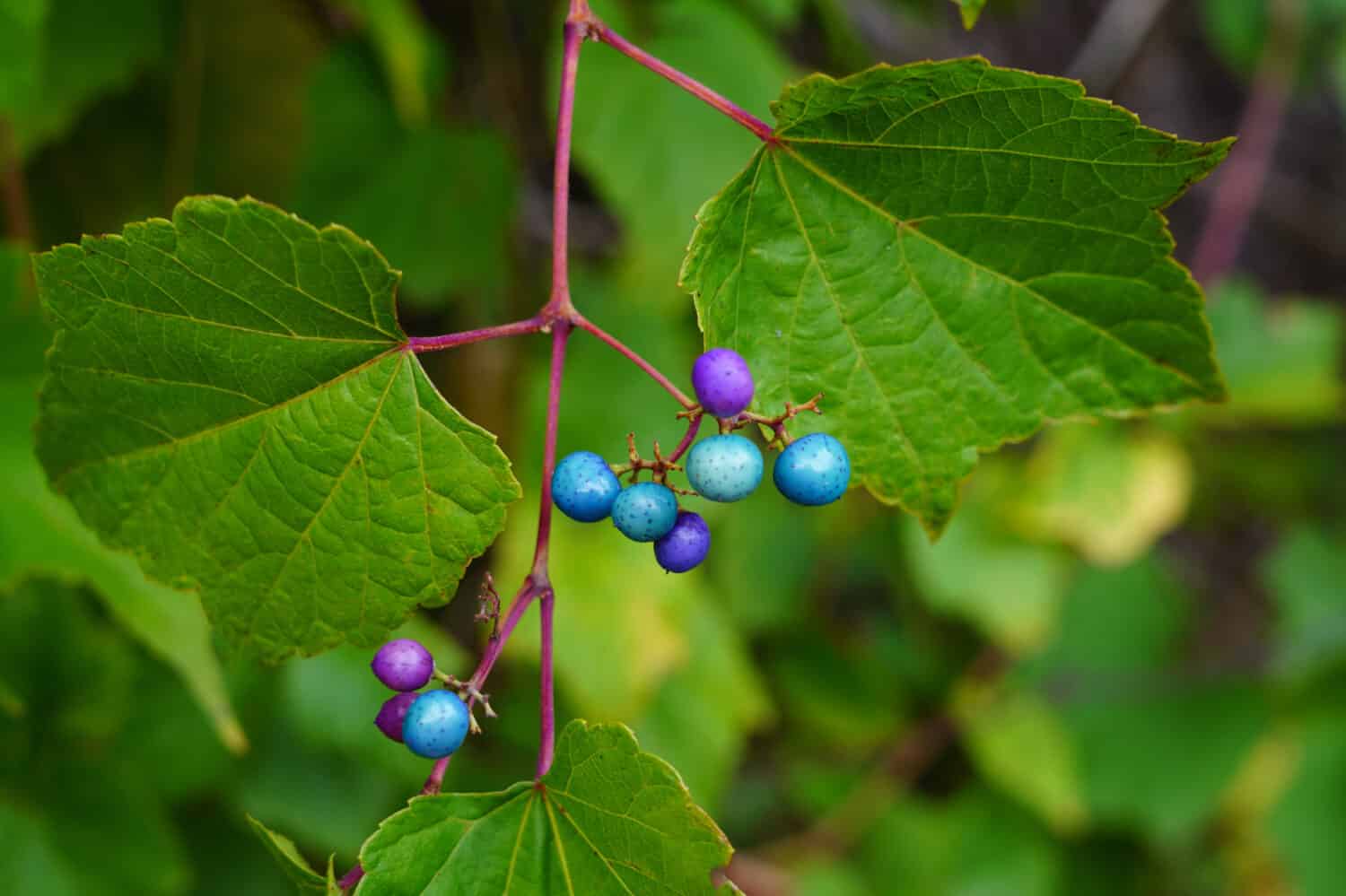
The invasive porcelain vine has many names, including the Amur pepper vine.
©EQRoy/Shutterstock.com
The porcelain vine, also known as the Amur pepper vine, is a fast-growing vine native to parts of Asia and Eastern Europe. It has heart-shaped leaves that are deep green in color and white flowers that bloom in the summer. The vine can grow up to 20 feet in a single season, making it an incredibly fast-growing plant.
Unfortunately, porcelain vine is also an incredibly invasive species. It can strangle trees by wrapping itself around them, leading to their death. It can also spread quickly and take over entire areas of land.
If you have porcelain vines on your property, it is important to take action quickly. You can manually remove the vines, but this can be incredibly time-consuming. An easier option is to use an herbicide to kill the vine. It is important to follow all the directions when using herbicides, as they can have a negative impact on the environment.
#9 Oriental Bittersweet
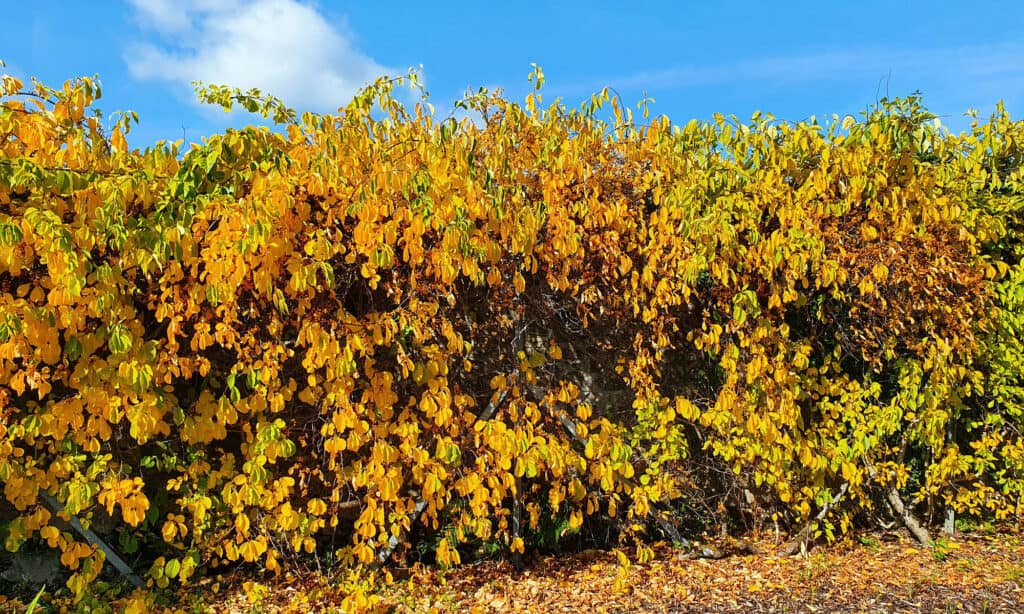
This gorgeous vine doesn’t look dangerous, but it can smother a tree to death in no time.
©iStock.com/TonyBaggett
Oriental bittersweet (Celastrus orbiculatus) is a fast-growing vine that is native to East Asia. The vine has yellow-green flowers and orange-yellow fruits that contain a single seed. The leaves of the vine are dark green, oval-shaped, and have smooth edges.
Oriental bittersweet grows rapidly and can grow up to 25 feet in one season. It is a vining plant and spreads by entwining itself around trees and buildings. The vine can quickly strangle and kill trees and other vegetation and can even cause damage to structures.
In order to control Oriental bittersweet, it is important to remove the vines from trees and other vegetation as soon as possible. If the vines are not removed, they can spread and cause further damage. If the vines are removed, it is important to dispose of them properly so that they do not spread to other locations.
How to Remove Vines From Trees
Vines that have grown large and wide have the potential to harm trees by depriving them of air, light, and essential nutrients in the soil. These vines can also form a tight grip on the tree by using hairs that cling to the bark. Removing these vines can be difficult and may require specialized tools such as a crowbar. Therefore, it is highly recommended that vines are eliminated as soon as possible.
Homeowners should take care when controlling vines on their trees. Cut out sections of about 6 inches in order to prevent them from transporting nutrients. When cutting the vines, it is essential to be cautious to not harm the bark or layers beneath the tree. Pruning shears are the best tool to use when cutting smaller vines, while a handsaw is sometimes necessary for larger vines.
When dealing with vines on trees, it is important to wear gloves to prevent their oils from touching your skin and causing irritation. Arborists also advise using rubbing alcohol before and after handling the vines, particularly when they are Poison Ivy. Winter is the best time to remove these vines as they are easier to reach and remove. Regardless of the season, it is wise to remove vines from trees quickly in order to protect them.
Vines That Don’t Kill Trees — Safe Vines
Growing certain vines on trees can be a great way to add extra color and texture to your garden. However, many vines can be dangerous to the health of the tree, as they can strangle and kill it. Fortunately, there are some options that are safe to plant on trees without the risk of harming them.
Clematis, crossvine, and passionflower are all examples of vines that are safe to grow on trees. These vines are non-invasive, and their structure is not damaging to the tree. They will climb up the trunk and branches without wrapping or twining too tightly. Furthermore, their root systems are shallow and not intrusive, so they will not damage the health of the tree.
In addition to these non-invasive vines, there are also some annual vines that are safe for trees. These vines die back during the winter, so they will not cause any long-term damage. Examples of these annual vines include hops and cucumbers.
Summary of 9 Vines That Can Choke Out and Kill Trees
| Rank | Vine | Location |
|---|---|---|
| #1 | Wisteria | Europe, Western Asia, and Northern Africa |
| #2 | Kudzu | Japan and Southeast China; Southeastern U.S. |
| #3 | Japanese Honeysuckle | East Asia (Japan and Korea) |
| #4 | Euonymus Vine | China, Japan, and Korea |
| #5 | English Ivy | Europe, Western Asia and Northern Africa |
| #6 | Virginia Creeper | Eastern U.S. |
| #7 | Poison Ivy | North America |
| #8 | Porcelain Vine | Asia and Eastern Europe |
| #9 | Oriental Bittersweet | East Asia |
Thank you for reading! Have some feedback for us? Contact the AZ Animals editorial team.






